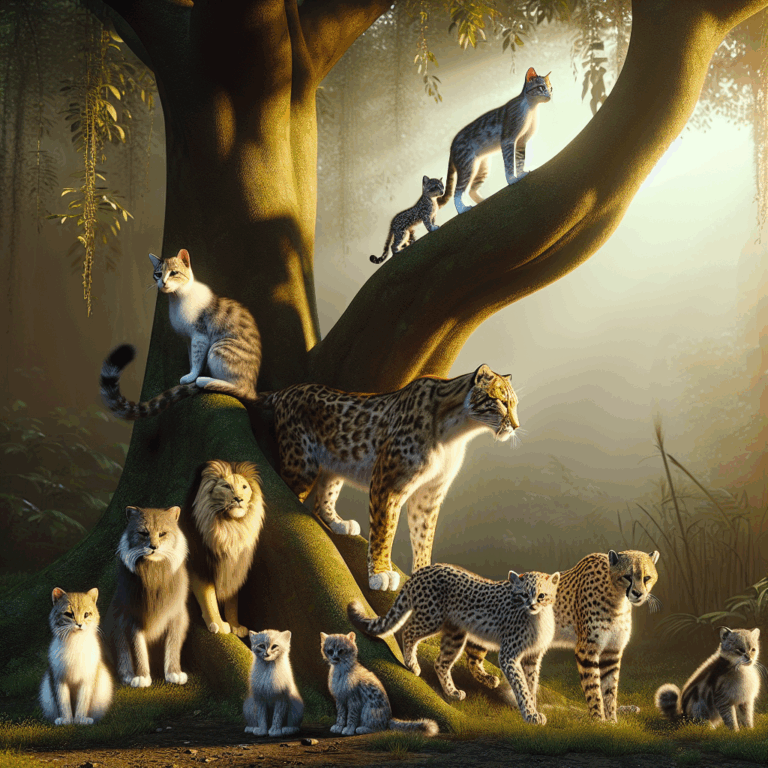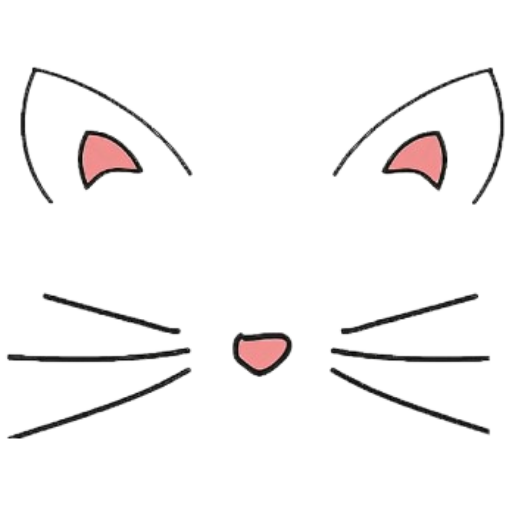The Feline Family Tree: Tracing the Ancestry of Domestic Cats
In the heart of the animal kingdom lies a creature whose history is as enigmatic as its demeanor — the domestic cat. While they may spend their days lounging on our sofas and their nights prowling our homes, the ancestral roots of these modern companions stretch back to a lineage of wild, independent forebears who roamed the earth millions of years ago. As we unravel the complex ancestry of domestic cats, we uncover a tale of adaptation, survival, and a remarkable partnership with humans that has stood the test of time.
The story of the domestic cat begins with a creature known as Proailurus, often dubbed the “first true cat,” which lived approximately 30 million years ago. This small, agile predator possessed the lithe body and retractable claws that are hallmarks of modern felines. Over the millennia, Proailurus gave rise to a diverse array of cat species, each adapting to their unique environments. From the saber-toothed cats to the mighty lions of the African savannah, these feline ancestors ruled the wild.
It wasn’t until about 10,000 years ago that the paths of humans and cats began to intertwine. The Fertile Crescent, often regarded as the cradle of civilization, served as the backdrop for this pivotal union. As humans transitioned from hunter-gatherer societies to settled agricultural communities, the storage of surplus grain attracted a common pest: rodents. Enter the African wildcat, Felis silvestris lybica, a solitary hunter with a taste for these pesky intruders. This mutually beneficial relationship marked the beginning of cat domestication, a process that was far less deliberate than that of dogs. Unlike their canine counterparts, who were bred by humans for specific traits, cats largely domesticated themselves by aligning their interests with those of humans.
As human societies expanded and evolved, so too did the role of cats. In ancient Egypt, they were revered as sacred animals, often depicted in art and associated with deities such as Bastet, the goddess of home, fertility, and protection. Cats were cherished for their ability to protect granaries from vermin, a service that further solidified their place in human communities. The reverence for cats spread across cultures, with cats making appearances in the mythology of Norse, Celtic, and Asian societies, each attributing their own significance to these mysterious creatures.
The journey of the domestic cat continued as they accompanied explorers, traders, and settlers across the globe. As cats spread to different regions, they adapted to new environments, leading to the development of various breeds. From the sleek Siamese cats of Thailand to the long-haired Persians of Iran, each breed carries distinct traits that reflect their geographic and cultural origins.
Despite their widespread presence in human history, the genetic makeup of domestic cats has remained relatively unchanged from their wild ancestors. This is partly due to their independent nature and less intensive selective breeding compared to dogs. However, scientific advances in genomics have allowed researchers to delve deeper into the cat’s genetic past, revealing fascinating insights into their evolutionary journey.
Today, the domestic cat continues to captivate and charm millions of people worldwide. From scientific studies that explore their behavior and genetics to cultural representations in art and media, cats remain a subject of endless fascination. As we trace the feline family tree, we not only uncover the rich tapestry of their past but also gain a greater appreciation for the unique bond we share with these remarkable creatures.

In the heart of the animal kingdom lies a creature whose history is as enigmatic as its demeanor — the domestic cat. While they may spend their days lounging on our sofas and their nights prowling our homes, the ancestral roots of these modern companions stretch back to a lineage of wild, independent forebears who roamed the earth millions of years ago. As we unravel the complex ancestry of domestic cats, we uncover a tale of adaptation, survival, and a remarkable partnership with humans that has stood the test of time.
The story of the domestic cat begins with a creature known as Proailurus, often dubbed the “first true cat,” which lived approximately 30 million years ago. This small, agile predator possessed the lithe body and retractable claws that are hallmarks of modern felines. Over the millennia, Proailurus gave rise to a diverse array of cat species, each adapting to their unique environments. From the saber-toothed cats to the mighty lions of the African savannah, these feline ancestors ruled the wild.
It wasn’t until about 10,000 years ago that the paths of humans and cats began to intertwine. The Fertile Crescent, often regarded as the cradle of civilization, served as the backdrop for this pivotal union. As humans transitioned from hunter-gatherer societies to settled agricultural communities, the storage of surplus grain attracted a common pest: rodents. Enter the African wildcat, Felis silvestris lybica, a solitary hunter with a taste for these pesky intruders. This mutually beneficial relationship marked the beginning of cat domestication, a process that was far less deliberate than that of dogs. Unlike their canine counterparts, who were bred by humans for specific traits, cats largely domesticated themselves by aligning their interests with those of humans.
As human societies expanded and evolved, so too did the role of cats. In ancient Egypt, they were revered as sacred animals, often depicted in art and associated with deities such as Bastet, the goddess of home, fertility, and protection. Cats were cherished for their ability to protect granaries from vermin, a service that further solidified their place in human communities. The reverence for cats spread across cultures, with cats making appearances in the mythology of Norse, Celtic, and Asian societies, each attributing their own significance to these mysterious creatures.
The journey of the domestic cat continued as they accompanied explorers, traders, and settlers across the globe. As cats spread to different regions, they adapted to new environments, leading to the development of various breeds. From the sleek Siamese cats of Thailand to the long-haired Persians of Iran, each breed carries distinct traits that reflect their geographic and cultural origins.
Despite their widespread presence in human history, the genetic makeup of domestic cats has remained relatively unchanged from their wild ancestors. This is partly due to their independent nature and less intensive selective breeding compared to dogs. However, scientific advances in genomics have allowed researchers to delve deeper into the cat’s genetic past, revealing fascinating insights into their evolutionary journey.
Today, the domestic cat continues to captivate and charm millions of people worldwide. From scientific studies that explore their behavior and genetics to cultural representations in art and media, cats remain a subject of endless fascination. As we trace the feline family tree, we not only uncover the rich tapestry of their past but also gain a greater appreciation for the unique bond we share with these remarkable creatures.



14 thoughts on “The Feline Family Tree: Tracing the Ancestry of Domestic Cats”
This post offers an insightful exploration into the fascinating history and evolution of our beloved feline companions.
It’s wonderful to hear that you found the exploration of feline history and evolution fascinating. The journey of domestic cats truly is intriguing!
Indeed, the history of domestic cats is truly captivating and their evolution is a remarkable journey. It’s amazing to see how these creatures have integrated into human life over the centuries.
While the post provides a detailed history of domestic cats, it overlooks the environmental impact of feral cat populations.
It’s great to see interest in the environmental aspect of feral cat populations. They indeed have a significant impact on local wildlife, and it’s an important issue to explore alongside the fascinating history of domestic cats.
You’re right, the environmental impact of feral cat populations is a crucial topic. It’s important to consider this alongside their intriguing history. It’s a complex issue that deserves attention and understanding.
This post beautifully explores the fascinating history and evolution of our beloved domestic cats.
I’m pleased you enjoyed the exploration of domestic cats’ history and evolution! It’s truly fascinating to see how these creatures have journeyed alongside humans over the millennia.
This post beautifully highlights the fascinating history and evolution of our beloved feline companions.
What a fascinating exploration into the rich history and enduring bond between humans and our feline companions!
This post wonderfully captures the fascinating history and journey of domestic cats through time.
Thank you for appreciating the article! It’s truly amazing to learn about the history and evolution of domestic cats. Their journey with humans is indeed remarkable.
The article provides an overview of feline history, yet lacks depth on key evolutionary stages and specific genetic adaptations. More detailed exploration of how domestic traits developed would enhance understanding.
This post beautifully unravels the captivating history of domestic cats and their enduring connection with humans.
Comments are closed.